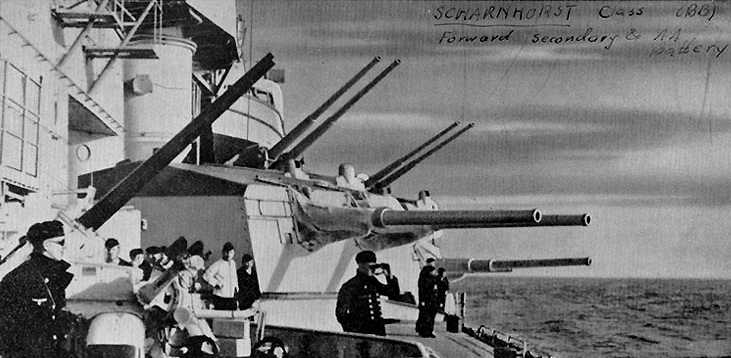
This weapon was used on the German Panzerschiffes and Battleships in both twin and single mounts and was considered to be quite successful. However, the German practice of using separate single purpose anti-ship and anti-aircraft batteries was wasteful of both space and weight.
A number of guns were used as coastal artillery. Two twin mountings originally planned for the cancelled carrier Graf Zeppelin were emplaced by September 1942 in northern Finland in the Petsamo area. A further two twin mountings were used in Northern Norway near Finmark. This latter battery was moved in 1945 to north of Tromsø. Following the German surrender, this battery was taken over by the Norwegians and then used as part of their coastal defenses at Harstad. When those defenses were decommissioned in 1989, one of these casemate twin mounts was moved to the Northern Fortress at Oscarsborg.
Other of these 15 cm guns survived in active service until long after the end of the war. The small battleship Gneisenau was decommissioned and dearmed in 1943, with her turreted guns then used in coastal fortifications in Denmark and her single guns used as railway guns. In 1952, Denmark moved the two turrets in Batterie Gneisenau at Fanø to Stevnsfort (Fort Stevns). These mountings were reduced to reserve status in 1984, but continued to be fired every year during training exercises. They "were fired for the last time in the summer of 2000, ending their operative career with an HE war-shot from turret No. 1, driven 17 kms (10 miles) into the Baltic Sea and raising a column of spray to a height of 150 m (500 feet), the shell detonating at an approximate depth of 17-18 m (55-60 feet), according to the commander of the fort at the time." The fort was officially deactivated in 2001 and now exists solely as a museum.
The main components of this gun were the loose barrel, a jacket and a breech end-piece with a vertical sliding wedge breech. The breech mechanism was hand worked.
All German 15 cm guns had an actual bore diameter of 14.91 cm (5.87 in).
| Designation | 15 cm/55 (5.9") SK C/28 |
|---|---|
| Ship Class Used On | Deutschland, Scharnhorst and Bismarck classes
Planned for "H" battleships, Kreuzer "M" and Graf Zeppelin classes |
| Date Of Design | 1928 |
| Date In Service | 1934 |
| Gun Weight 1 | 19,900 to 20,018 lbs. (9,026 to 9,080 kg) |
| Gun Length oa | 323 in (8.200 m) |
| Bore Length | 307.7 in (7.816 m) |
| Rifling Length | 259 in (6.588 m) |
| Grooves | (44) 0.069 in deep x 0.242 in (1.75 mm x 6.14 mm) |
| Lands | 0.177 in (4.5 mm) |
| Twist | Increasing RH 1 in 50 to 1 in 30 |
| Chamber Volume | 1,324 in3 (21.7 dm3) |
| Rate Of Fire | 6 - 8 rounds per minute |
- ^Gun weight varied according to the grade of steel used.
| Type | Separate |
|---|---|
| Projectile Types and Weights 1a 2a 3a | APC L/3,8: 99.9 lbs. (45.3 kg)
HE L/4,5 base fuze: 99.9 lbs. (45.3 kg) HE L/4,6 nose fuze 4a: 99.9 lbs. (45.3 kg) HE L/4,6 nose fuze, AA 5a: 98.5 lbs. (44.7 kg) HE L/4,6 nose fuze incendiary: 103.2 lbs. (46.8 kg) Illum L/4,3: 90.4 lbs. (41.0 kg) |
| Bursting Charge 6a | APC L/3,8: 2.43 lbs. (1.103 kg) TNT 7a HE L/4,5 base fuze: 6.74 lbs. (3.058 kg) TNT 8a HE L/4,6 nose fuze: 8.58 lbs. (3.892 kg) TNT 9a HE L/4,6 nose fuze AA: 8.58 lbs. (3.892 kg) TNT 10a HE L/4,6 nose fuze incendiary: 6.61 lbs. (3.0 kg) TNT + 4.85 lbs. (2.2 kg) incendiary 11a |
| Projectile Length 12a | APC L/3,8: about 22.4 in (57.0 cm)
HE L/4,5 base fuze: about 26.6 in (67.5 cm) HE L/4,6 nose fuze: about 27.2 in (69.0 cm) HE L/4,6 nose fuze AA: N/A HE L/4,6 nose fuze incendiary: about 27.2 in (69.0 cm) Illum L/4,3: 25.4 in (64.5 cm) |
| Propellant Charge 13a | 31.5 lbs. (14.30 kg) RP C/32 (825 x 8/3,5)
- or - 31.2 lbs. (14.15 kg) RP C/38 (825 x 7,5/3) |
| Cartridge Case Size and Weight | 150 x 865 mm
Empty: 18.83 lbs. (8.54 kg) Loaded: 51.8 lbs. (23.5 kg) |
| Muzzle Velocity | AP and HE: 2,871 fps (875 mps)
Illum: N/A |
| Working Pressure | 19 tons/in2 (3,000 kg/cm2) |
| Approximate Barrel Life | 1,100 rounds |
| Ammunition stowage per gun 14a | Bismarck and "H": 105 to 150 rounds
Scharnhorst: 133 to 150 rounds Panzerschiffes: 100 to 150 rounds Graf Zeppelin: 115 rounds "M" class: 120 rounds |
- ^The sources below differ regarding the ammunition used for these weapons. For the most part, I have relied upon the data in M.Dv. Nr. 198 and in "German Capital Ships of World War Two."
- ^All but the AA and Illum projectiles used ballistic caps (windshields).
- ^
Actual German designations APC L/3,8 15 cm Pzgr. L/3,8 (m.Hb) HE L/4,5 base fuze 15 cm Spgr. L/4,5 Bdz (m.Hb) HE L/4,6 nose fuze 15 cm Spgr. L/4,6 Kz (m.Hb) HE L/4,6 nose fuze, AA 15 cm Spgr L/4,6 Kz (m.Hb) – Haube abgeschraubt [unscrewed cap] HE L/4,6 nose fuze incendiary 15 cm Spgr L/4,6 Kz (m.Hb) Br Illumination L/4,3 15 cm Lg L/4,3 - ^German HE Nose Fuzed projectiles with ballistic caps had a rod between the nose of the shell and the fuze to improve performance when striking obliquely. See details on 12.7 cm SK C/34 datapage.
- ^The post-war USN NAVTECMISEU Technical Report #191-45 "Standard German Projectile Fuzes" lists the time fuze Z.Z. S/60 nA as being used on the 15 cm Spgr L/4,6 Kz (m.Hb) which implicitly means that sometime during the war an AA version of this projectile was issued. The AA projectile was the same as the standard HE Nose Fuze projectile, but had a time fuze in place of the instantaneous impact fuze and did not use the ballistic cap (windshield). See Anti-Aircraft Projectiles for a sketch. These AA projectiles were used at least once by Tirpitz when she was attacked in her Norwegian Fjord on 12 November 1944.
- ^Burster weights (reiner Sprengstoff) from M.Dv. Nr. 198.
- ^The burster for the APC L/3,8 projectile was made from Fp 10 and Fp 1.
- ^The burster for the HE L/4,5 base fuze projectile was made from Fp 15, Fp 10, Fp 5 and Fp 1.
- ^The burster for the HE L/4,6 nose fuze projectile was made from Fp 1.
- ^The burster for the HE L/4,6 nose fuze AA projectile was made from Fp 1.
- ^Burster for HE base fuze incendiary made from Fp 2 (TNT) and Brandkörper C (incendiary).
- ^APC and HE ballistic caps had a radius of 8.5 calibers. The tangent of the ballistic cap to the shell body was inclined at 5 degrees, which resulted in a projectile with a short overall length.
- ^A Note on Sources: "German Naval Guns: 1939 - 1945" claims that fore charges were used for these guns, but I have found no other official source that supports this statement. In addition, an examination of M.Dv. Nr. 190,4A6, the Oberkommando der Kriegsmarine technical document issued in 1942 regarding fore charges (Vorkartusche), finds no listing for this weapon nor for any other gun smaller than the 20.3 cm guns carried by the Admiral Hipper class cruisers.
- ^Outfits included APC, HE base fuze and HE nose fuze with and without tracer and illumination. However, APC was rarely carried.
| Elevation | Distance |
|---|---|
| 35 degrees | 24,060 yards (22,000 m) |
| 40 degrees | 25,153 yards (23,000 m) |
| Designation 1b | Twin Turrets 2b
Scharnhorst (4), Bismarck (6) and "H" (6): Dop. L. C/34 (Drh L. C/34) Kreuzer "M": N/A (Possibly Drh L. C/40) Single Pedestal Mounts
Casemate Twin Mounts
|
|---|---|
| Weight | Twin Turrets
Bismarck Turrets w/rangefinder: 256,290 lbs. (116,250 kg) Turrets w/o range finder: 242,500 lbs. (110,000 kg) Turrets w/o range finder and short barbette: 238,100 lbs. (108,000 kg) Scharnhorst: 264,555 lbs. (120,000 kg) Kreuzer "M": 242,508 lbs. (110,000 kg) Single Pedestal Mounts
Casemate Twin Mounts
|
| Elevation | Drh Mounts: -10 / +40 degrees
MPL/28 and MPL/35 Mounts: -10 / +35 degrees MPL/36 Mounts: -10 / +37 degrees |
| Elevation Rate | 8 degrees per second |
| Train 3b | 360 degrees |
| Train Rate | 9 degrees per second |
| Gun recoil | 14.6 in (37 cm) |
| Loading Angle | About +3 degrees |
- ^Single MPL/28 mounts on the Deutschland class were modified to add armor protection and some had double doors installed on the back of the open shield in order to provide weather protection to the gun and crew. The MPL/35 mounts on the Scharnhorst class were similar in design but were roomier and had additional armor protection.
- ^The guns in the twin turrets were individually sleeved. The center turret on each side of Bismarck and Tirpitz was a "Command Turret" that was equipped with a 6.5 m (21 feet 4 inches) rangefinder. These turrets could pass firing data to the other 15 cm turrets. None of the 15 cm turrets on Scharnhorst and Gneisenau had rangefinders.
- ^Most of these mountings were designed to be able to make one complete revolution in either direction from the mid (fore and aft) position for a total of 720 degrees of train. Firing arcs were restricted to about -75 / +75 degrees for the battleships and about -150 / +150 degrees on the cruisers.
- The gun axes were 68.9 inches (175 cm) apart in the twin turrets and 31.5 inches (80 cm) apart in the twin casemate mounts.
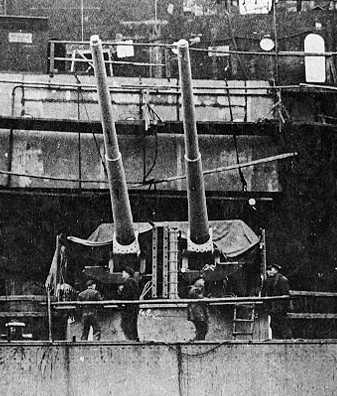
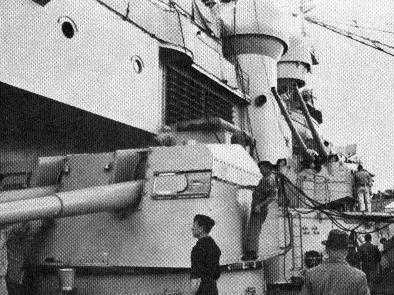
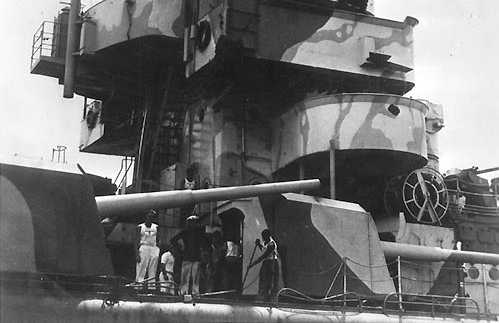
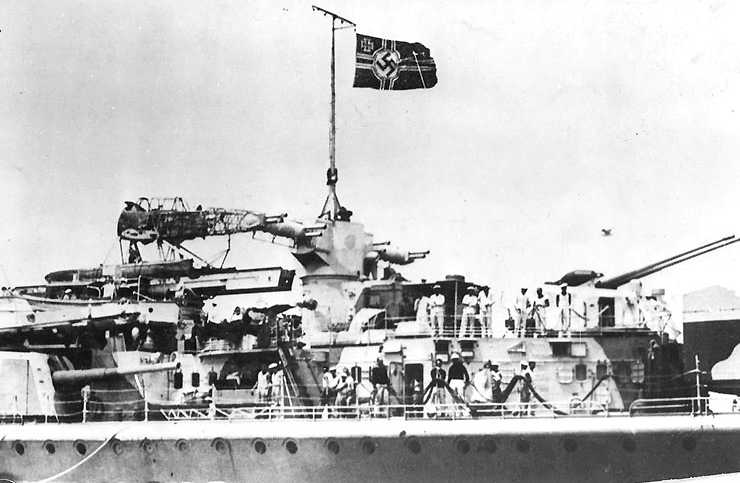
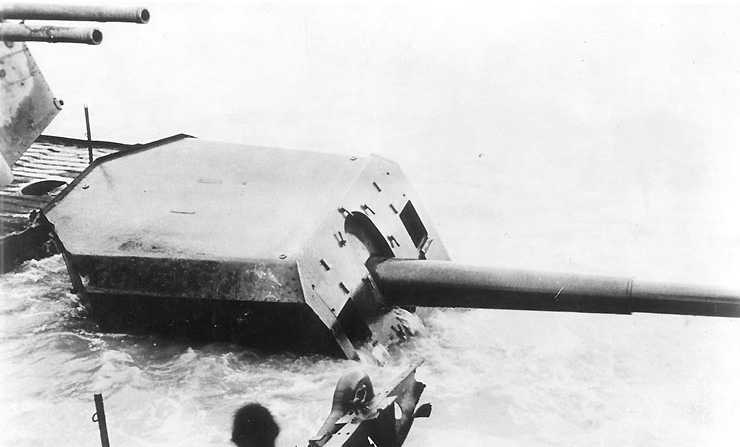
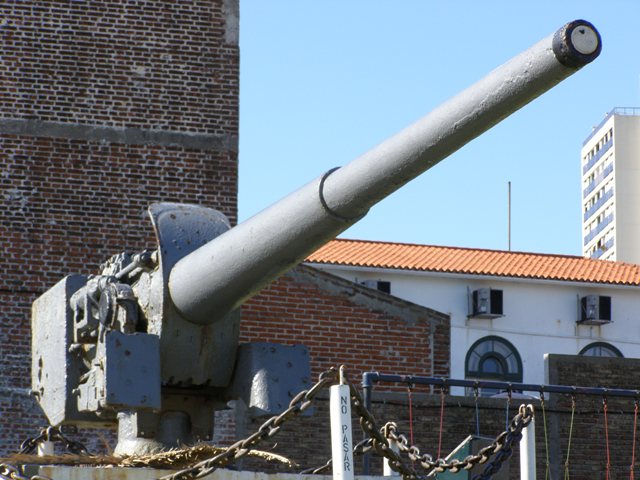
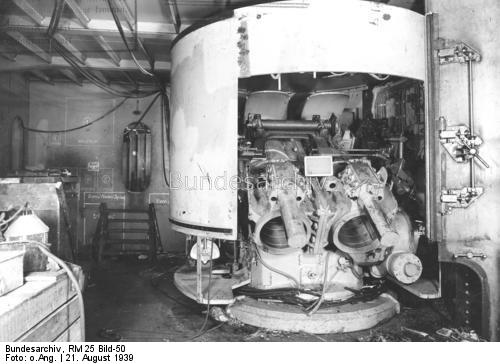
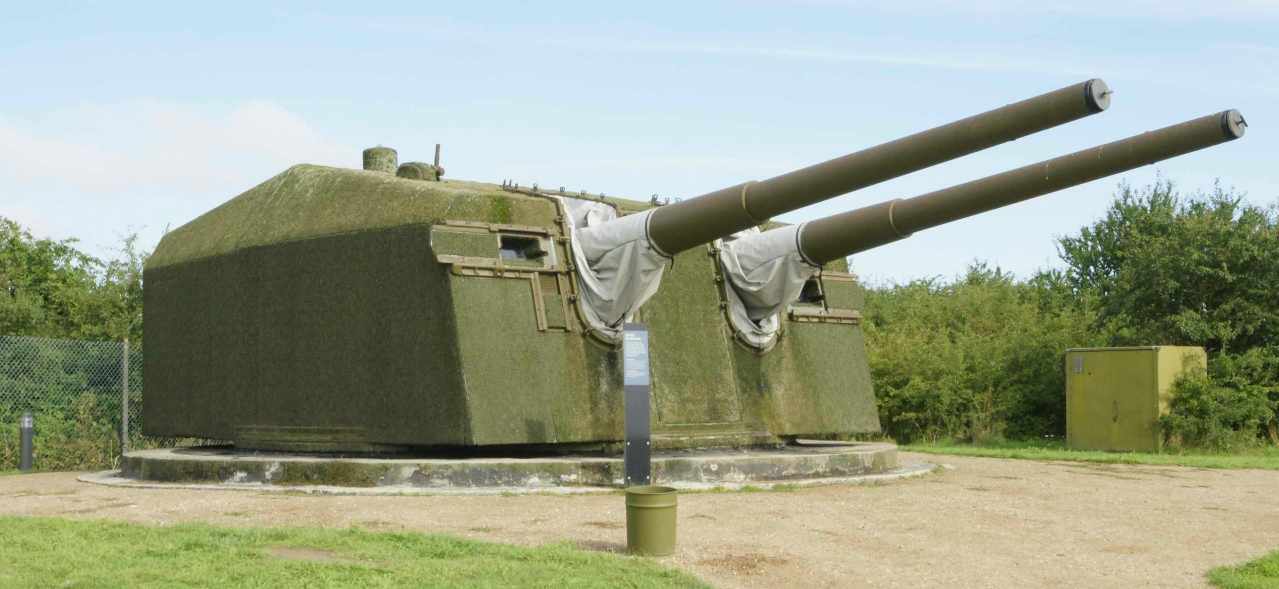
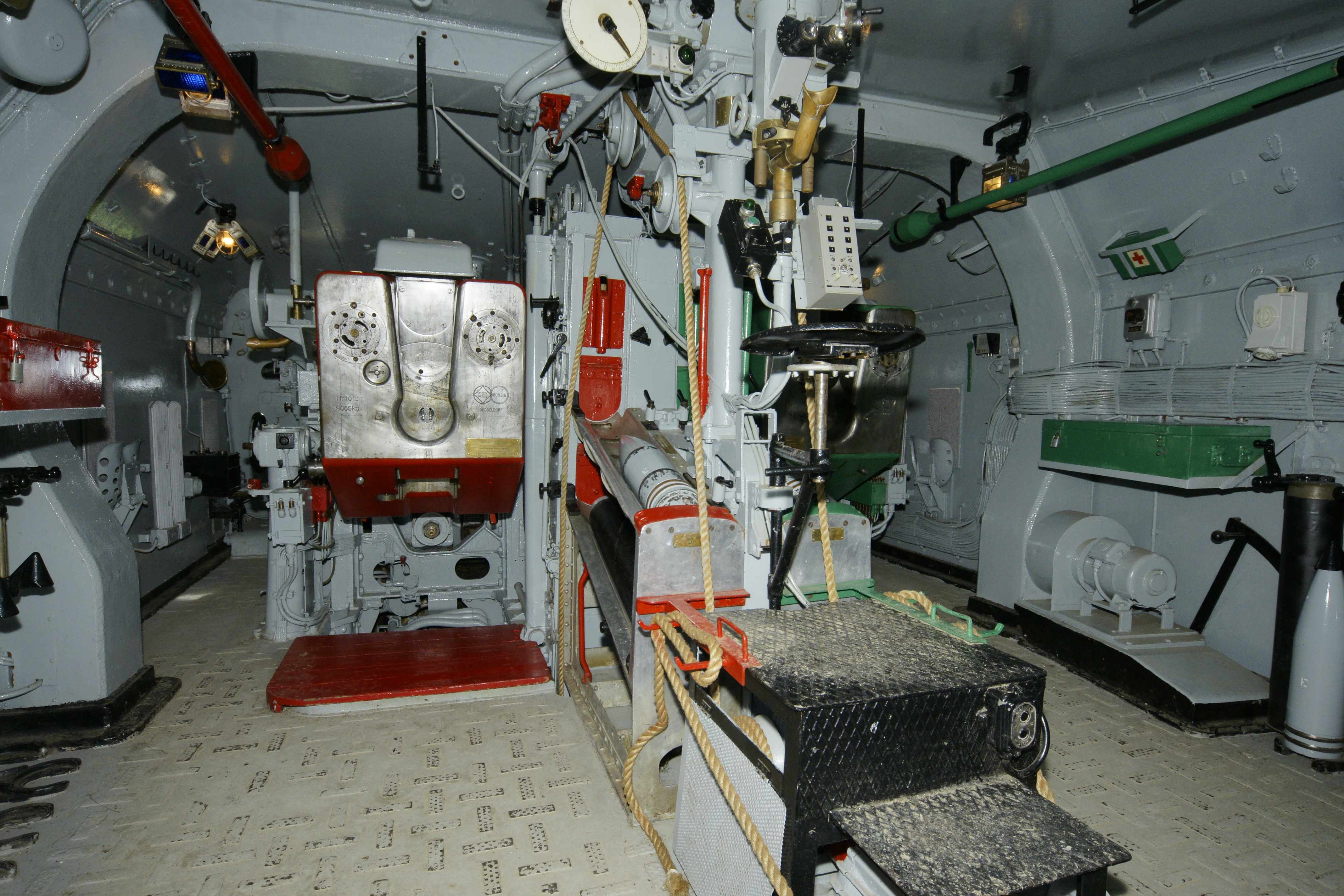
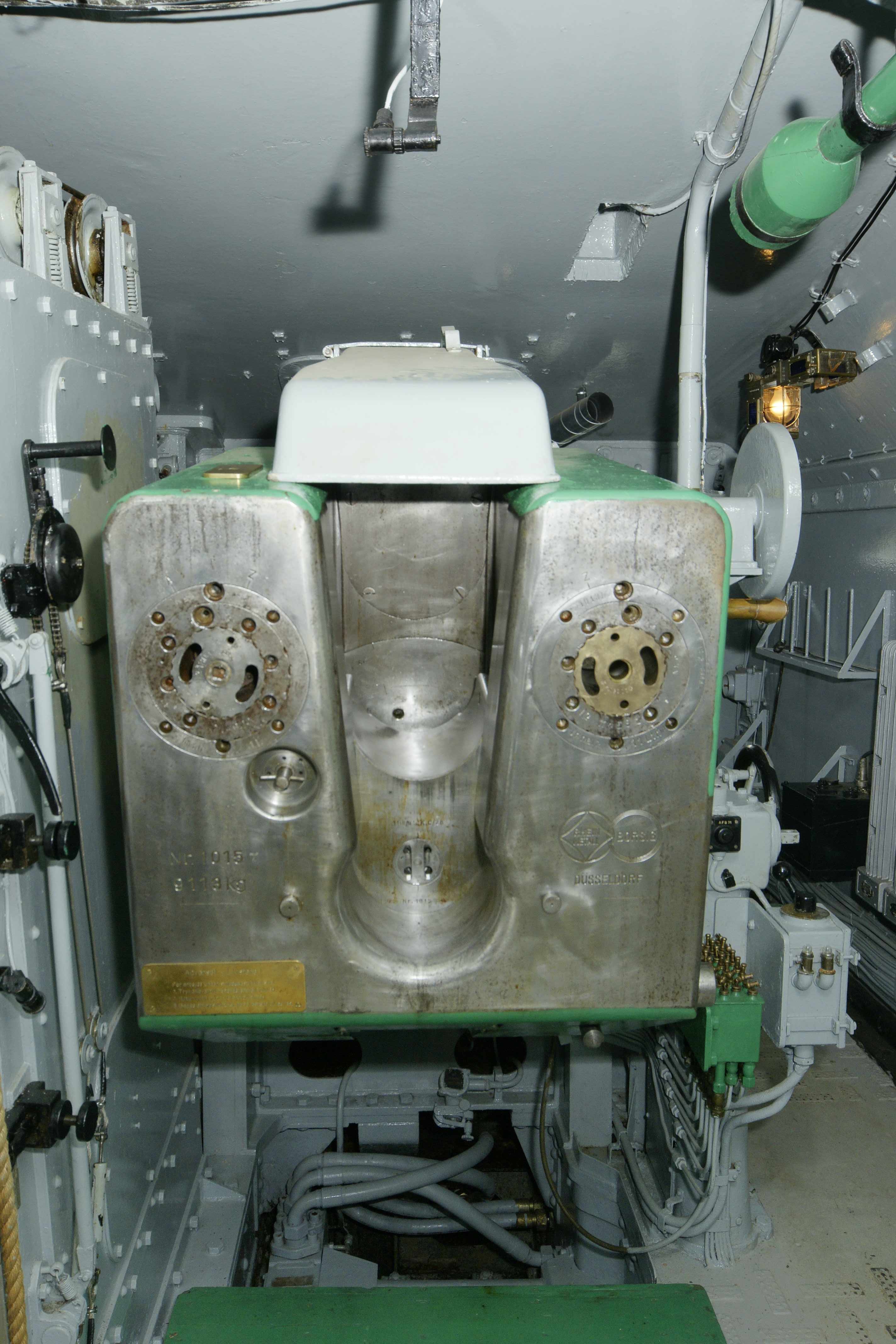
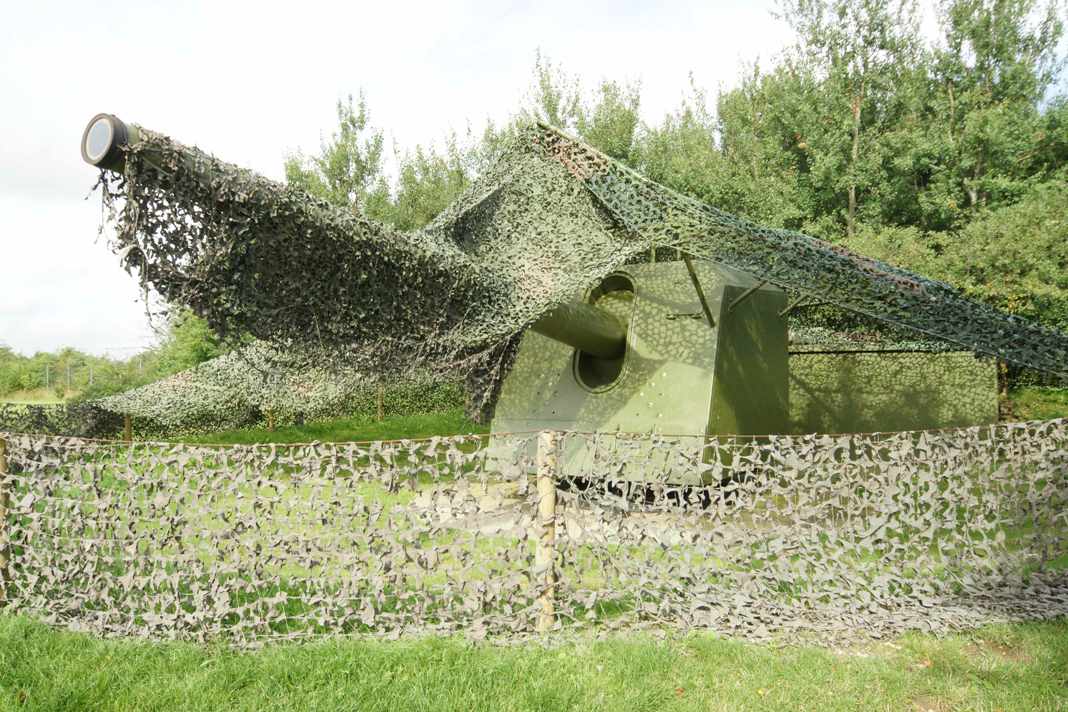
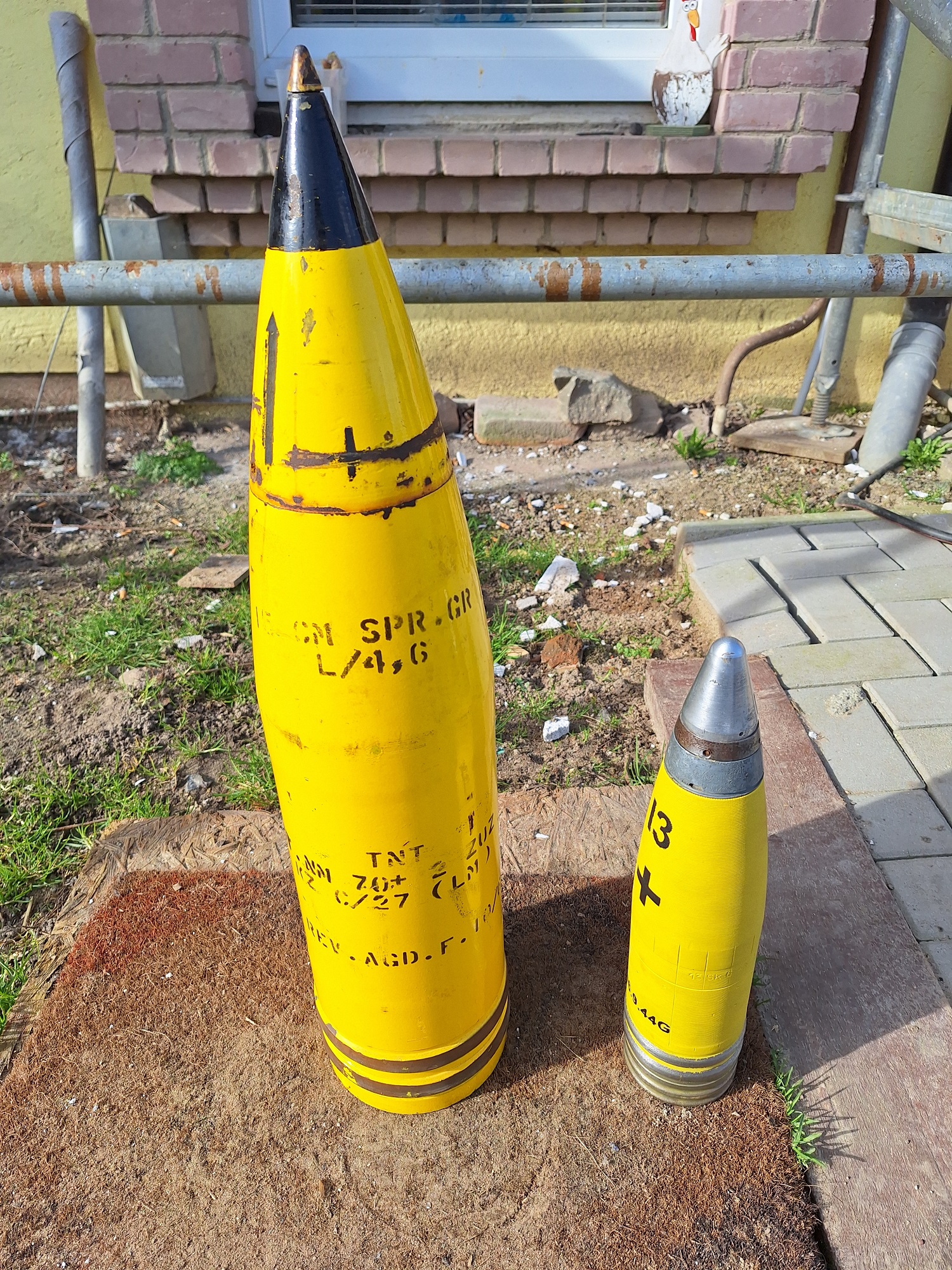
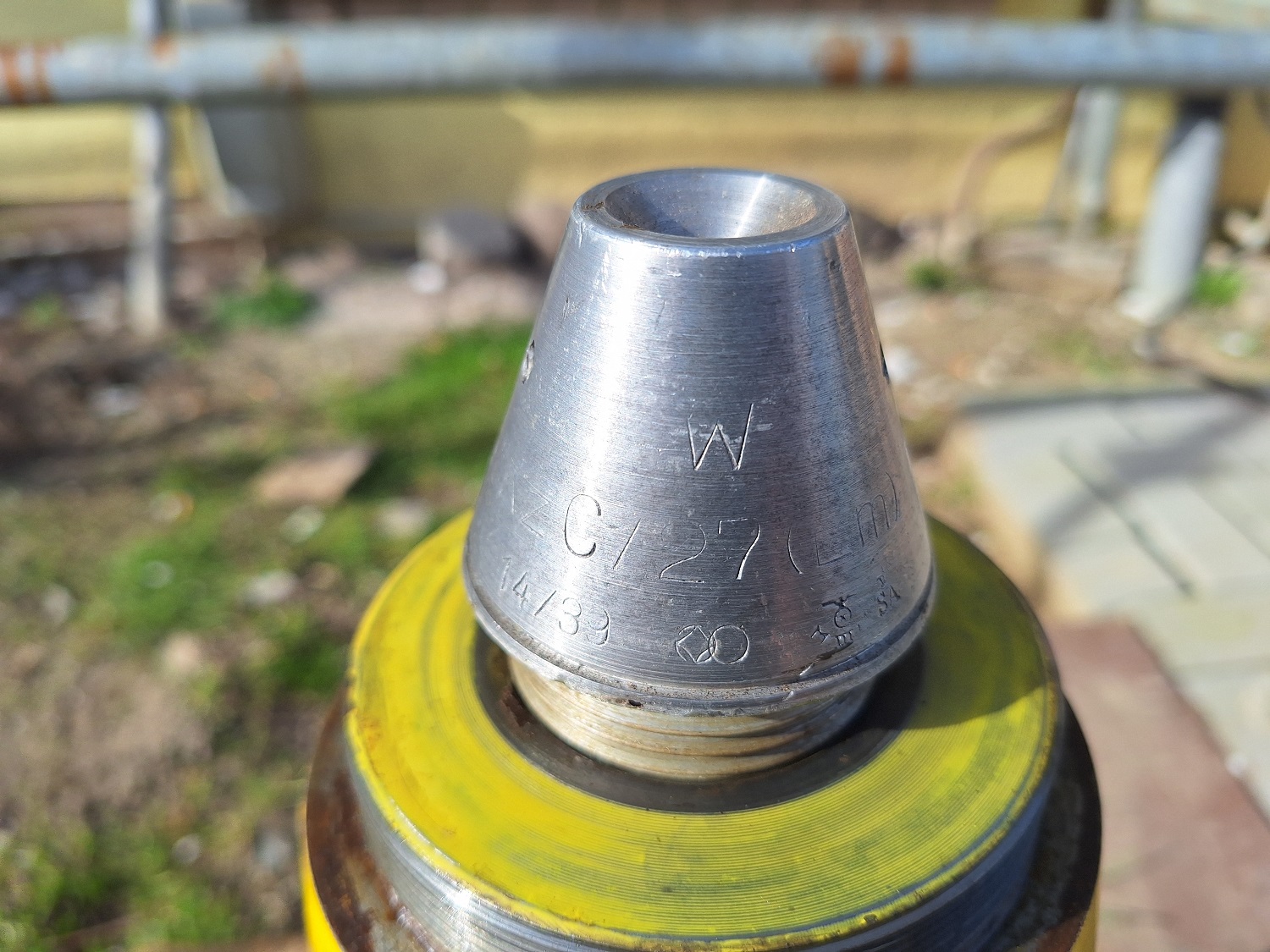
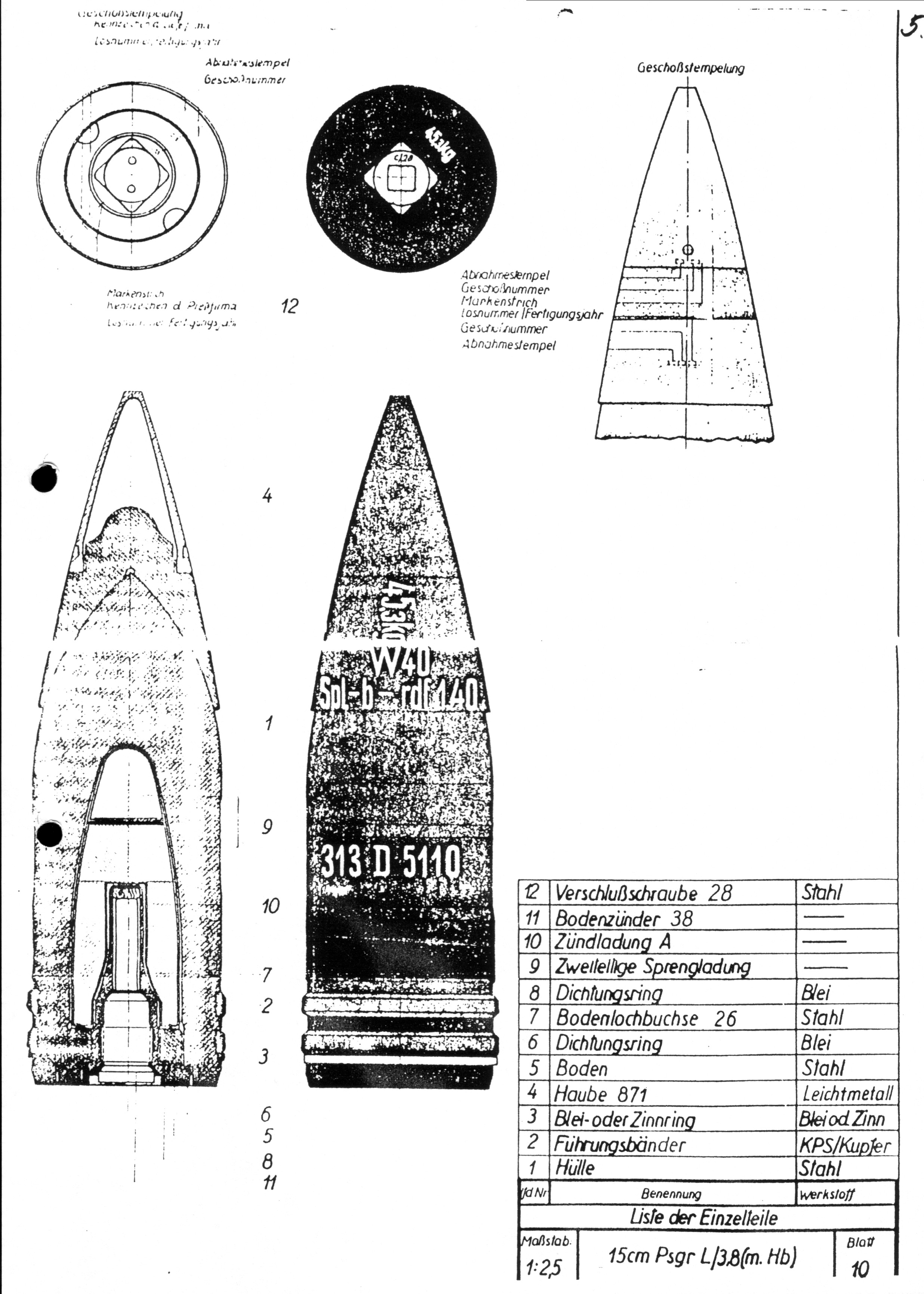
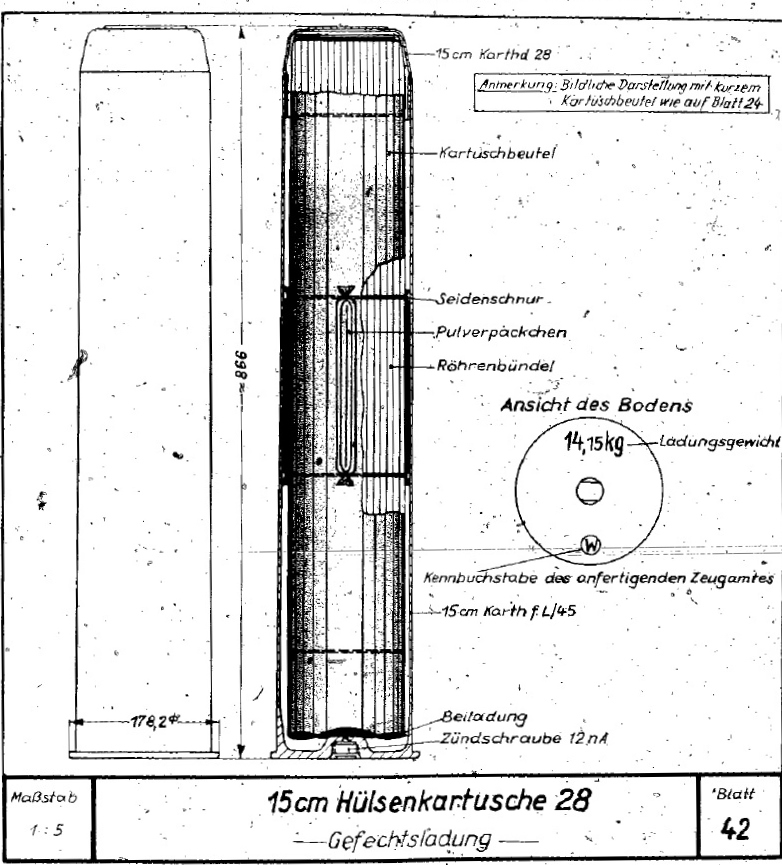
Front View of Twin Casemate Mount at Oscarsborg Fortress, near Oslo, Norway.
Rear View of Twin Casemate Mount at Oscarsborg Fortress, near Oslo, Norway.
"Naval Weapons of World War Two" by John Campbell
"The Naval Institute Guide to World Naval Weapon Systems 1994 Update" by Norman Friedman
"Battleships: Axis and Neutral Battleships in World War II" by W.H. Garzke, Jr. and R.O. Dulin, Jr.
"German Warships 1815-1945" by Erich Gröner
"German Naval Guns: 1939 - 1945" by Miroslaw Skwiot
"German Cruisers of World War Two," "German Capital Ships of World War Two" and "Graf Zeppelin" article in "Warship Volume VIII" all by M.J. Whitley
---
Letter by Arne Ingar Tandberg in "Warship Volume X"
---
"Merkbuch: über die Munition für die 15 cm SK C/25 der Schiffsartillerie" M.Dv. Nr. 170,30 by Oberkommando der Kriegsmarine
"Munitionsvorschriften für die Kriegsmarine (Artillerie), 1A" M.Dv.Nr. 190 by Oberkommando der Kriegsmarine
"Munitionsvorschriften für die Kriegsmarine - Panzersprenggranaten mit Haube - a) Psgr (m.Hb)" M.Dv. Nr. 190,1A1 by Oberkommando der Kriegsmarine
"Munitionsvorschriften für die Kriegsmarine - Hülsenkartusche" M.Dv. Nr. 190,4A1 by Oberkommando der Kriegsmarine
"Munitionsvorschriften für die Kriegsmarine - Vorkartusche" M.Dv. Nr. 190,4A6 by Oberkommando der Kriegsmarine
"Übersicht über die für die Marinegeschütze und deren Abk K zu verwendende Munition und ihre Einzelteile einschließlich Salut-
und Manöverladungen" M.Dv. Nr. 198 by Oberkommando der Kriegsmarine
---
Special help by Bjarne Carlsen, 1st Lt, RDAF and Thorsten Wahl
20 November 2008 - Benchmark
07 April 2011 - Added projectile and cartridge case information
20 May 2012 - Updated to latest template
07 November 2016 - Converted to HTML 5 format
23 February 2018 - Reorganized notes
22 February 2019 - Added information and notes to Ammunition section, added sketches from M.Dv. Nr. 190,1A1 and M.Dv. Nr. 190,4A1
27 March 2019 - Added information on AA projectile
25 August 2019 - Added link to AA Projectile section
13 October 2019 - Added information about twin turrets on Bismarck class
03 April 2020 - Added comment regarding the use of AA projectiles by Tirpitz
16 April 2021 - Corrected typographical error
06 January 2023 - Added information on use of Gneisenau guns in coastal defense batteries
26 February 2024 - Added photographs of 15 cm Spgr. L/4,6 Kz (m.Hb) and Kz C/27 fuze
02 May 2024 - Added "Off-Site Photographs" section
29 August 2024 - Added burster notes and ammunition information
01 March 2025 - Minor changes
17 April 2025 - Added incendiary projectile
